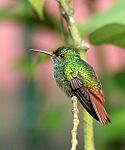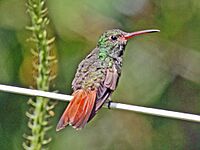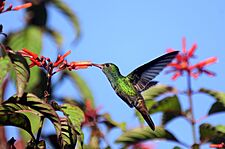Rufous-tailed hummingbird facts for kids
Quick facts for kids Rufous-tailed hummingbird |
|
|---|---|
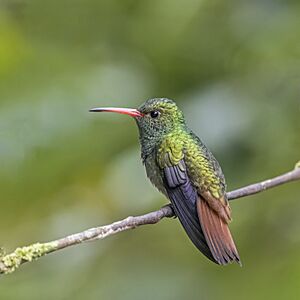 |
|
| A male Rufous-tailed Hummingbird in Colombia | |
| Conservation status | |
| Scientific classification | |
| Genus: |
Amazilia
|
| Species: |
tzacatl
|
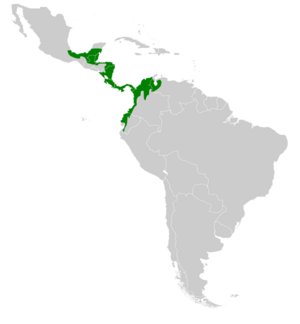 |
|
| Where this hummingbird lives | |
The rufous-tailed hummingbird (Amazilia tzacatl) is a medium-sized hummingbird. It belongs to a group of hummingbirds called "emeralds". You can find this bird from east-central Mexico all the way through Central America and Colombia. Its range also extends into Ecuador and Venezuela.
Contents
About the Rufous-tailed Hummingbird's Name
The Rufous-tailed Hummingbird was first officially described in 1833. This was done by a Mexican scientist named Pablo de La Llave. He gave it the scientific name Trochilus tzacatl.
Later, in 1843, a French scientist named René Lesson placed it in the genus Amazilia. A genus is a group of similar animals or plants. The name Amazilia comes from a brave Inca princess in an old story. The second part of its name, tzacatl, comes from an Aztec warrior chief.
There are five different types, or subspecies, of the Rufous-tailed Hummingbird:
- A. t. tzacatl
- A. t. handleyi
- A. t. fuscicaudata
- A. t. brehmi
- A. t. jucunda
Scientists once thought one of these, A. t. handleyi, was a completely separate species. However, they later decided it was a subspecies of the Rufous-tailed Hummingbird.
What the Rufous-tailed Hummingbird Looks Like
The Rufous-tailed Hummingbird is about 9 to 11 centimeters (3.5 to 4.3 inches) long. It weighs around 5 grams (0.18 ounces), which is very light!
Colors and Markings
Adult male Rufous-tailed Hummingbirds have a green head and back. They have chestnut-brown feathers around their eyes and on their upper tail. Their tail is mostly chestnut-brown, which is how they got their name. The outer parts of their tail feathers are bronze-green.
Their throat, upper chest, and sides are also green. Sometimes, the throat feathers have thin white edges, making them look a bit scaly. Their lower chest is gray, and their belly is white. The feathers under their tail are chestnut-brown.
Female birds have a lighter gray lower chest than males. The scaly look on their throat is also more noticeable. Young hummingbirds have a cinnamon color on their lower chest and sides. The feathers on their lower back have thin cinnamon tips.
The top part of their beak is black on the outer half and red on the inner half. The bottom part of their beak is red with a black tip.
Sounds and Calls
The Rufous-tailed Hummingbird's song is varied. It sounds like high, thin, squeaky chirping. You might hear sounds like "tsi, tsi-tsi-tsit tsi-tsitsi tsi-si-si."
Their calls are a hard, smacking "tchik-tchik" or "tchi tchi." They sometimes repeat these sounds quickly. They also make a dry, rattling sound like "chirr-rr-rr-rr-rr."
Differences in Subspecies
The A. t. handleyi subspecies looks like the main type but is bigger and darker. A. t. fuscicaudata is smaller and has a shorter, thicker beak.
The A. t. jucunda subspecies has a pinkish-brown upper beak instead of black. Its belly is darker gray, and the bronze-green on its tail is less noticeable. A. t. brehmi is similar to jucunda and fuscicaudata but has longer wings and tail.
Where the Rufous-tailed Hummingbird Lives
The different types of Rufous-tailed Hummingbirds live in various places:
- A. t. tzacatl lives from eastern Mexico south through Belize, Guatemala, Honduras, Nicaragua, and Costa Rica. It also lives in most of Panama.
- A. t. handleyi lives on Isla Escudo de Veraguas, an island off the coast of Panama.
- A. t. fuscicaudata lives in the river valleys of northern and western Colombia. It also lives in western Venezuela.
- A. t. brehmi lives near the Güiza River in Colombia.
- A. t. jucunda lives from western Colombia south through western Ecuador.
Scientists believe A. t. jucunda might also live in Peru.
Habitats and Elevation
These hummingbirds like open areas, not dense forests. You can find them in clearings, gardens, and along the edges of forests. They also live in young, bushy forests that have grown back after trees were cut down. They often visit bird feeders in people's yards.
They live at different heights depending on the country. In Mexico, they live from sea level up to 1,200 meters (3,900 feet). In Costa Rica, they can be found up to 1,850 meters (6,070 feet). In Colombia, they live up to 1,800 meters (5,900 feet), and in Venezuela, up to 1,700 meters (5,600 feet). In Ecuador, they can be found as high as 2,500 meters (8,200 feet), but this might only be in certain areas or seasons.
Behavior of the Rufous-tailed Hummingbird
Feeding Habits
Like most hummingbirds, the Rufous-tailed Hummingbird eats nectar from flowers. Nectar is a sweet liquid. They also eat small insects. You can often see them at sugar water feeders. They are also common in coffee and banana farms.
These birds are very protective of their feeding spots, like flower patches or feeders. They will chase away other hummingbirds and even large insects to keep their food source to themselves.
Reproduction and Life Cycle
Rufous-tailed Hummingbirds are polygynous. This means one male bird mates with several female birds. Even though they are aggressive when feeding, they sometimes build their nests close to each other in small groups.
Their breeding season changes depending on where they live. It can happen anytime between February and November. The female hummingbird does all the work for raising the young. She builds the nest, sits on the eggs to keep them warm, and takes care of the baby birds.
She lays two white eggs in a small, cup-shaped nest. The nest is made from plant fibers, leaves, and spiderwebs. It's covered with lichens and moss to help it blend in. The nest is usually placed up to 6 meters (20 feet) high on a thin branch. The eggs hatch after 15 to 19 days. The young birds are ready to fly out of the nest after another 18 to 22 days.
Conservation Status
The IUCN (International Union for Conservation of Nature) has listed the Rufous-tailed Hummingbird as a species of "Least Concern." This means they are not currently in danger of disappearing.
They live in a very large area, and there are more than five million adult birds. Even though their numbers might be slowly going down, they are still very common. In fact, human activities like cutting down forests can sometimes help them. This is because deforestation creates more open spaces, which they prefer. They also do well in coffee and banana farms and enjoy visiting bird feeders.
Gallery
-
A Rufous-tailed Hummingbird in Panama



